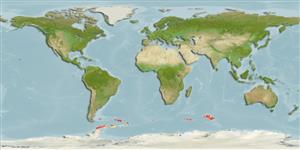Preferred temperature (Réf.
123201): -1.1 - 2.9, mean 1.5 °C (based on 50 cells).
Phylogenetic diversity index (Réf.
82804): PD
50 = 0.7500 [Uniqueness, from 0.5 = low to 2.0 = high].
Bayesian length-weight: a=0.00120 (0.00102 - 0.00142), b=3.47 (3.42 - 3.52), in cm total length, based on LWR estimates for this species (Ref.
93245).
Niveau trophique (Réf.
69278): 3.2 ±0.2 se; based on diet studies.
Résilience (Réf.
120179): Milieu, temps minimum de doublement de population : 1,4 à 4,4 années (K=0.13-0.39; tmax=13; tm=4; Fec=3,094).
Prior r = 0.39, 95% CL = 0.26 - 0.59, Based on 2 data-limited stock assessments.
Fishing Vulnerability (Ref.
59153): Moderate vulnerability (35 of 100).
🛈
Climate Vulnerability (Ref.
125649): High to very high vulnerability (68 of 100).
🛈
Nutrients (Ref.
124155): Calcium = 20.5 [11.1, 44.8] mg/100g; Iron = 0.388 [0.165, 0.801] mg/100g; Protein = 16.9 [14.8, 18.9] %; Omega3 = 0.222 [0.107, 0.473] g/100g; Selenium = 25.9 [9.2, 64.1] μg/100g; VitaminA = 13.8 [2.8, 70.5] μg/100g; Zinc = 0.409 [0.265, 0.626] mg/100g (wet weight); based on
nutrient studies. 